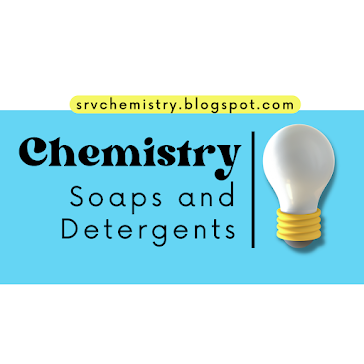Cleansing Agents
In this Section, we will learn about soaps and detergents. Two types of cleansing agents are used for cleaning:
1. Soaps
2. Detergents.
These improve the cleansing properties of water. These help in removal of fats which bind other materials to the fabric or skin.
Soaps
Soaps used for cleaning purpose are sodium or potassium salts of long chain fatty acids, e.g., stearic, oleic and palmitic acids. Soaps containing sodium salts are formed by heating fat (i.e., glyceryl ester of fatty acid) with aqueous sodium hydroxide solution. This reaction is known as SAPONIFICATION.
Generally, oil/dirt does not dissolve in water, soap helps water to remove oil/dirt.
Only sodium and potassium soaps are soluble in water and are used for cleaning purposes. Generally potassium soaps are soft to the skin than sodium soaps. These can be prepared by using potassium hydroxide solution in place of sodium hydroxide.
Cleansing Action of Soap
A soap molecule consists of two parts:
1. Hydrophilic Part It is a polar part like -COONa. This is water soluble, therefore remain attached to water molecule.
2. Hydrophobic Part It is a long chain hydrocarbon which is non-polar end. It is a water repelling and is soluble in oil/grease.
Working: The oil/dirt are insoluble in water but when we apply soap to the mixture, the oil/dirt solubilizes into the water. The insoluble oil/dirt molecule become associated inside the "Micelles" which is a tiny sphere formed from soap molecule with polar hydrophilic part outside and hydrophobic group inside, which shield the oil/dirt molecule from water and making it soluble with hydrophobic part. Anything that is soluble will be washed away with water.
Limitations of Soaps
1. Soaps are not suitable for washing with Hard water. Ca and Mg ion present in hard water combine with soap forming insoluble sticky precipitate called Scum. This result in wastage of soap.
2. Scum formed with soap in hard water discolour and hardens the fabrics of clothes.
3. Soaps cannot be used for woolen clothes.
Why do soaps not work in hard water?
When clothes are washed in hard water with soaps, the dirt is not washed off and the soap does not form lather. The hard water often contain dissolved Ca and Mg salts, the sodium ion present in soap reacts with these dissolved salts and forms SCUM (sticky precipitate) in water and are useless as cleansing agent. In fact these are hindrance to good washing, because the precipitate adheres onto the fibres of the cloth as gummy mass.
Hair washed with hard water looks dull because of this sticky precipitate.
Dye does not absorb evenly on cloth washed with soap using hard water, because of this gummy mass.
Detergents (Soapless Soap)
Detergents are cleansing agents which have all the properties of soaps, but which actually do not contain any soap. These can be used both in soft and hard water as they give foam even in hard water. Some of the detergents give foam even in ice cold water.
Synthetic detergents are mainly classified into three categories:
(i) Anionic Detergents
(ii) Cationic Detergents and
(iii) Non-Ionic Detergents
Anionic Detergents
Anionic detergents are sodium salts of sulphonated long chain alcohols or hydrocarbons.
Alkyl hydrogen sulphates formed by treating long chain alcohols with concentrated sulphuric acid are neutralised with alkali to form anionic detergents.
Similarly alkyl benzene sulphonates are obtained by neutralising alkyl benzene sulphonic acids with alkali.
In anionic detergents, the anionic part of the molecule is involved in the cleansing action.
Sodium salts of alkyl benzene sulphonates are an important class of anionic detergents. They are mostly used for household work. Anionic detergents are also used in toothpastes.
Cationic Detergents
Cationic detergents are quaternary ammonium salts of amines with acetates, chlorides or bromides as anions.
Cationic part possess a long hydrocarbon chain and a positive charge on nitrogen atom. Hence, these are called cationic detergents.
Cetyl trimethylammonium bromide is a popular cationic detergent and is used in hair conditioners.
Cationic detergents have germicidal properties and are expensive, therefore, these are of limited use.
Non-Ionic Detergents
Liquid dishwashing detergents are non-ionic type.
Disadvantages of using Detergents
Slow degradation of detergents leads to their accumulation. Effluents containing such detergents reach the rivers, ponds, etc and water gets polluted (i.e Non biodegradable)
These days the branching of the hydrocarbon chain is controlled and kept to the minimum. Unbranched chains can be biodegraded more easily and hence pollution is prevented.


